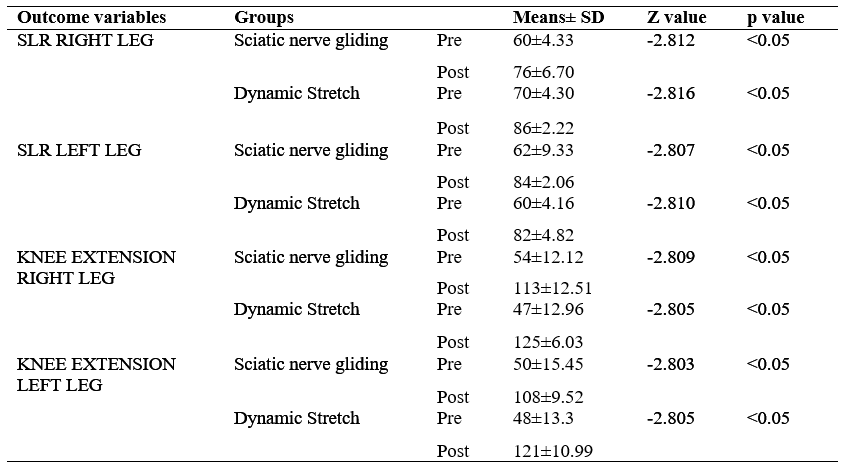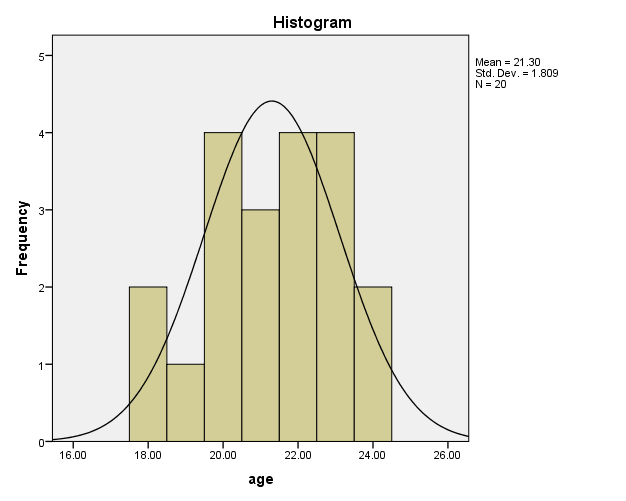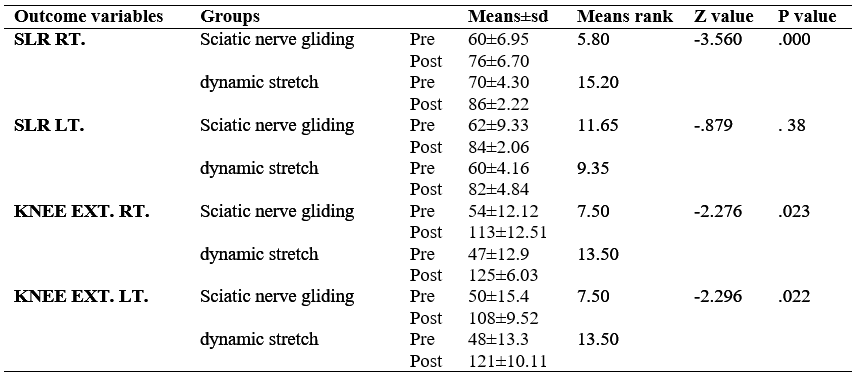Sidra Shafique1*, Sara Aabroo2, Hafiza Neelum Muneeb3, Umair Arshad4
1*Senior Lecturer, RCRS, Riphah International University, Lahore, Pakistan![]()
2Senior Lecturer, RCRS, Riphah International University, Lahore, Pakistan![]()
3Student, RCRS, Riphah International University, Lahore, Pakistan![]()
4Student, RCRS, Riphah International University, Lahore, Pakistan![]()
Abstract
Background: Hamstring muscles are targeted among football players. Sciatic nerve gliding improve hamstring flexibility among football players.
Objective: To compare the effects of sciatic nerve gliding and lower extremity stretching on hamstring flexibility among football players.
Methodology: In this randomized clinical trial 20 male athletes were selected which divided in two groups. One group was given sciatic nerve gliding while other lower extremity stretches. Athletes with age of 18-30 years, male foot ballers who regularly exercise 2 to 3 times a week for 30 minutes for 6 weeks were included. Goniometer was used to collect data by performing straight leg raise and Active knee extension test.
Results: The results showed that the mean age and SD was 21.30±1.809. Comparison of treatment within group was checked by Wilcoxon Rank test showed significant results (P was less than 0.05 )and between group comparisons was checked by Mann Whitney test and found sciatic nerve gliding gave more improvement in Athletes performance (p value was less than 0.05 for straight leg raising and active knee extension test.
Conclusion: It was concluded that sciatic nerve gliding gave more effective results than lower stretching in increasing hamstring flexibility among football players.
Keywords: Football, hamstring muscles, muscle stretching exercises, lower extremity, sciatic nerve, neurodynamics.

Introduction
The hamstrings fundamentally influence adaptability of the body, and diminished hamstring adaptability brings about diminishes in trunk dependability and money owed to inappropriate change of the gluteus Maximus and stomach muscles1,3.The hamstring muscles is a significant part in the presentation of day by day exercises like Dynamic Stretched development of the storage compartment, strolling, running, and bouncing , and it is a significant muscle associated with keeping up with equilibrium and stance in standing position4,5. Increased hamstring’s flexibility plays a contributing role in enhancing athletic overall performance6. Balanced muscle tissues maintains joint’s range of movement, which improves the encircling muscle groups’ blood supply and contractibility, decreases put on and tear on the articular systems encapsulating the joint, promotes recuperation of confused tissue, and assists in motor-mastering strategies to make sure extra powerful and accurate overall performance techniques7,8. Recently created strategies to build the adaptability of the hamstrings incorporate static extending, contract-loosen up extending, thermo-treatment, rub, and neurodynamics9,10. Neurodynamics is a manual technique for applying power to nerve structures through act and multi-joint development11,13. In light of the rule that the sensory system ought to be likewise extended and contracted appropriately to keep up with ordinary muscle pressure and guarantee scope of movement14,15. Previously, it has arisen as prominent that a pre-body heat-up before active work can without a moment’s delay impact execution11. Generally, a pre-action heat-up has included low profundity cardio practicing and some state of extending, alongside static or dynamic stretching16. Warming up can likewise affect muscle strength and force, athletic execution, joint assortment of development17, muscle adaptability, and possibility of injury12,18. Moreover, the impact of a warm-up on physical issue decrease is uncertain19. In this manner, it’s miles basic to place in power amazing procedures of warming as much as accomplish the most adequate results and to save you mishaps8,20.Dynamic stretching has been defined as a ‘‘managed movement thru the lively range of movement for every joint’’ there may be some proof to suggest that dynamic stretching enhances electricity, agility sprinting overall performance vertical leap height and electromyography pastime measured at some stage in an isometric maximal voluntary contraction19. Neurodynamic is known to be very effective technique in increasing flexibility of hamstring muscles and is thought to be useful way to reduce neural mechanosensitivity (the specific response to mechanical stimulation)21,22. In Neurodynamic techniques, neural structures slide respectively to the nearby structures. The method to apply force is by postural method and movement of multi joint with the objective to stretch and slide neurodynamic structures9,23. The literature describes four common strategies of assessing hamstring muscle period those consist of the knee extension angle take a look at, the sacral angle take a look at, the straight leg boost check, and the sit-and-reach take a look at.7,16.
Hamstring muscles flexibility is very important among football players. By giving lower extremity stretching’ and sciatic nerve gliding blood supply and contractibility of muscle improved. The rationale of current study is to compare the effects of sciatic nerve gliding and lower extremity stretching’s on hamstring flexibility among football players.
Objective
To compare the effects of sciatic nerve gliding and lower extremity stretching’s on hamstring flexibility among football players
Methodology
Study Design
Randomized clinical trial. Randomization was done by lottery method. The Non probability convenient sampling technique was used. The study was single blinded (Assessor blinded). The sample was calculated by epitool software. Sample size was (n1): 10 athletes (n2): 10 athletes
Total Sample Size
Both groups have 20 athletes. The data collection Tools was used Universal Goniometer, Knee extension test, Straight leg raise test.
Duration
This study was 10 months.
Setting
Data was collected from Pakistan Sports Board Coaching Center, Lahore.
Inclusion Criteria
was footballers male with 18 to 30 years and having hamstring tightness of one or both legs, unable to achieve more than 160o knee extension with hip at 90o flexion and can reach <70o hip flexion in SLR.
Exclusion Criteria
Athletes with prior history of injury in lumber area, level of activity low for last three days, any disorder of low back like disc slip or herniation etc. and with the history of lower limb fracture were excluded from study.
Data Collection Procedure and Treatment Approach
After taking consent, participants were randomly selected and assigned in two groups. A 5 minutes warm up and cool down session were given before and after the treatment respectively and it was same for both groups. Before starting the exercise participants was assessed by using goniometer by performing straight leg raise and active knee were performed for both pretreatment and post treatment evaluation. After noticing down the measurements participants were divided in to two group. First group was given Sciatic nerve gliding and its procedure was force was applied at the proximal end and then released distally which is done by applying force on the proximal and repeat the processing in reverse order. This process was applied for thirty seconds and six times on each leg for three minutes (360 seconds). Second group was given lower extremity dynamic stretching. It was applied on the ankle in downward direction by holding for 30 seconds and repeated five times for total three minutes (360 seconds).this was done on both legs .total Treatment was of 3 weeks with 2 sessions per week.
Results
Analysis was through SPSS version 21. Graph 1 showed that Mean age and SD of athletes was 21±1.809. Within group comparison was done between pre and post treatment values which showed mean and SD for SLR right leg (60±4.33),( 76±6.70)and for SLR left was(62±9.33),(84±2.06) while mean ±SD for the knee extension test right were (54±12.12), (113±12.51) and for the knee extension test left were (50±15.45), (108±9.52) p<0.05 for all which is statically significant in table 1.

Table 1: Comparison within Groups

Table 2: Between Group Comparison
The of difference in sciatic nerve gliding and Dynamic Stretch group by using Mann Whitney test which showed mean and SD for SLR right leg (60±6.95),( 76±6.70)Mean rank (5.80) and for SLR left was(62±9.33),( 84±2.06)Mean rank (11.65) while mean ±SD for the knee extension test right were(54±12.12),( 113±12.51) and Mean rank (7.50) and for the knee extension test left were(50±15.4),( 108±9.52)Mean rank (7.50) and p<0.05 for all which is statically significant and showed sciatic nerve gliding was more effective in improving hamstring flexibility in table 2.

Table 2: Between Group Comparison
Discussion
Current Study showed that sciatic nerve gliding was more effective in improving hamstring flexibility. Similar study from previous literature found in 2020 conducted by Danguole Satkunskieneet et al showed that viscoelastic behavior of the sciatic nerve was affected by stretching technique whereas more increase in the extensibility of hamstrings was due to the results of neurodynamic technique as a consequent of increased length of connective tissues and decreased nerve tension. So conclusion was made that neuro dynamic technique gave better results in increasing the extensibility of hamstrings. Current study’s findings also showed that sciatic nerve stretching is more effective21.
In contrast to current study, In 2019 Chaitali Shah et al, conducted a research which concluded that sciatic nerve gliding technique is less effective than the stretching of hamstrings. While the study reported it as well that both the techniques i.e. sciatic nerve gliding and stretching of hamstring are effective in their own way. According to current study comparison of active stretching and sciatic nerve gliding, sciatic nerve gliding gave more effective results22.
The current study supports the findings of the study conducted by A Balci et al in the year 2020 on wrestlers, revealed that the flexibility of hamstrings is increased by neural sliding and neural stretching exercises of the sciatic nerve24.
AR Ahmed et al. 2016 in the study short term effects of neurodynamic stretching and static stretching techniques on hamstring muscle flexibility in healthy male subjects concluded that flexibility of hamstrings could be increased markedly by neurodnamic stretching technique as comparative to sciatic nerve stretching in males with hamstring tightness.Current study also showed similar results 25. In contrast to current study, In 201 Amit Kumar Singh et al conducted study that concluded that PNF stretching is found to be more effective in increasing flexibility of hamstrings than Neurodynamic sliding in students of college. While the current study concluded opposite findings that sciatic nerve gliding to be more effective in increasing hamstring flexibility26.
Conclusion
On the basis of result, it was concluded that sciatic nerve gliding gave more effective results than lower limb stretching in increasing hamstring flexibility among football players.
AUTHORS’ CONTRIBUTION:
The following authors have made substantial contributions to the manuscript as under:
Conception or Design: Sidra Shafiq, Sara Aabroo
Acquisition, Analysis or Interpretation of Data: Hafiza Neelum Muneeb,
Manuscript Writing & Approval: Umair Arshad
All authors acknowledge their accountability for all facets of the research, ensuring that any concerns regarding the accuracy or integrity of the work are duly investigated and resolved.
ACKNOWLEDGEMENTS: We thanks all the participants in this study.
INFORMED CONSENT: Written Informed Consent was taken from each patient.
CONFLICT OF INTEREST: The author (s) have no conflict of interest regarding any of the activity perform by PJR.
FUNDING STATEMENTS: None declared
ETHICS STATEMENTS: N/A
References
- Waldhelm A, Gacek M, Davis H, Saia C, Kirby B. Acute effects of neural gliding on athletic performance. International journal of sports physical therapy. 2019;14(4):603.
- Aksoy CC, Kurt V, Okur İ, Taspınar F, Taspinar B. The immediate effect of neurodynamic techniques on jumping performance: a randomised double-blind study. Journal of back and musculoskeletal rehabilitation. 2020;33(1):15-20.
- Lempainen L, Banke IJ, Johansson K, Brucker PU, Sarimo J, Orava S, et al. Clinical principles in the management of hamstring injuries. Knee Surgery, Sports Traumatology, Arthroscopy. 2015;23(8):2449-56.
- Behm DG, Blazevich AJ, Kay AD, McHugh M. Acute effects of muscle stretching on physical performance, range of motion, and injury incidence in healthy active individuals: a systematic review. Applied physiology, nutrition, and metabolism. 2016;41(1):1-11.
- Silvers-Granelli HJ, Cohen M, Espregueira-Mendes J, Mandelbaum B. Hamstring muscle injury in the athlete: state of the art. Journal of ISAKOS: Joint Disorders & Orthopaedic Sports Medicine. 2021;6(3):170-81.
- Wing C, Bishop C. Hamstring Strain Injuries: Incidence, Mechanisms, Risk Factors, and Training Recommendations. Strength & Conditioning Journal. 2020;42(3):40-57.
- Ramos GA, Arliani GG, Astur DC, Pochini AdC, Ejnisman B, Cohen M. Rehabilitation of hamstring muscle injuries: a literature review☆. Revista brasileira de ortopedia. 2017;52:11-6.
- Subburam A. Effect of Neurodynamic Sliding and Dynamic Range of Motion Training on the Flexibility of Hamstring Muscle: A Comparative study: College of Physiotherapy, Sri Ramakrishna Institute of Paramedical Sciences …; 2018.
- Ali S, Sharma S. Efficacy of Neural Mobilisation in Hamstring Strain Injury: Current Update.
- Bonser RJ, Hancock CL, Hansberger BL, Loutsch RA, Stanford EK, Zeigel AK, et al. Changes in hamstring range of motion after neurodynamic sciatic sliders: A critically appraised topic. Journal of sport rehabilitation. 2017;26(4):311-5.
- Areeudomwong P, Oatyimprai K, Pathumb S. A randomised, placebo-controlled trial of neurodynamic sliders on hamstring responses in footballers with hamstring tightness. The Malaysian journal of medical sciences: MJMS. 2016;23(6):60.
- De Ridder R, De Blaiser C, Verrelst R, De Saer R, Desmet A, Schuermans J. Neurodynamic sliders promote flexibility in tight hamstring syndrome. European journal of sport science. 2020;20(7):973-80.
- Pratiksha G, Bharati A. Comparison of immediate effect on hamstring flexibility using non ballistic active knee extension in neural slump position and static stretch technique. International Journal of Physiotherapy and Research, Int J Physiother Res. 2017;5(6):2425-31.
- Ferreira J, Bebiano A, Raro D, Martins J, Silva AG. Comparative effects of tensioning and sliding neural mobilization on static postural control and lower limb hop testing in football players. Journal of sport rehabilitation. 2019;28(8):840-6.
- Coppieters MW, Andersen LS, Johansen R, Giskegjerde PK, Høivik M, Vestre S, et al. Excursion of the sciatic nerve during nerve mobilization exercises: an in vivo cross-sectional study using dynamic ultrasound imaging. Journal of orthopaedic & sports physical therapy. 2015;45(10):731-7.
- Gamelas T, Fernandes A, Magalhães I, Ferreira M, Machado S, Silva AG. Neural gliding versus neural tensioning: Effects on heat and cold thresholds, pain thresholds and hand grip strength in asymptomatic individuals. Journal of bodywork and movement therapies. 2019;23(4):799-804.
- Ortiz MI, Cortés-Márquez SK, Romero-Quezada LC, Murguía-Cánovas G, Jaramillo-Díaz AP. Effect of a physiotherapy program in women with primary dysmenorrhea. European Journal of Obstetrics & Gynecology and Reproductive Biology. 2015;194:24-9.
- Williams JA. Lower Extremity Neurodynamic Mobilization and Its Effect on Range of Motion in Collegiate Football Athletes: Texas A&M University-Commerce; 2018.
- Ganesh SH. Comparative Study of the Effects of Neurodynamic Sliding vs Suboccipital Muscle Inhibition Technique on Flexibility of Hamstring in Asymptomatic Subjects with Hamstring Syndrome. International Journal of Clinical Skills. 2017;11(4).
- Medeiros DM, Miranda LLP, Marques VB, de Araujo Ribeiro-Alvares JB, Baroni BM. Accuracy of the functional movement screen (fmstm) active straight leg raise test to evaluate hamstring flexibility in soccer players. International journal of sports physical therapy. 2019;14(6):877.
- Satkunskiene D, Ra’ad MK, Muanjai P, Mickevicius M, Kamandulis S. Immediate effects of neurodynamic nerve gliding versus static stretching on hamstring neuromechanical properties. European Journal of Applied Physiology. 2020;120(9):2127-35.
- Jeanbart K, Tanner-Bräm C. Mobilization of the Neurodynamic System Using Proprioceptive Neuromuscular Facilitation Decreases Pain and Increases Mobility in Lower Extremities and Spine-A Case Report. Journal of Bodywork and Movement Therapies. 2021.
- Shah C, Amin H, Siyani M. Effect of Nordic eccentric hamstring stretching exercise and sciatic nerve slider technique of neural mobilization in college students: A Comperative study. 2019.
- Balcı A, Ünüvar E, Akınoğlu B, Kocahan T. The effect of different neural mobilization exercises on hamstring flexibility and functional flexibility in wrestlers. Journal of Exercise Rehabilitation. 2020;16(6):503.
- Ahmed AR, Samhan AF. Short term effects of neurodynamic stretching and static stretching techniques on hamstring muscle flexibility in healthy male subjects. International Journal of Medical Research & Health Sciences. 2016;5(5):36-41.
- Singh AK, Nagaraj S, Palikhe RM, Neupane B. Neurodynamic sliding versus PNF stretching on hamstring flexibility in collegiate students: a comparative study. Int J Phys Educ Sports Health. 2017;1(1):29-33.
The Ziauddin University is on the list of I4OA, I4OC, and JISC.
This is an open- access article distributed under the terms of the Creative Commons Attribution License (CC BY 4.0).
